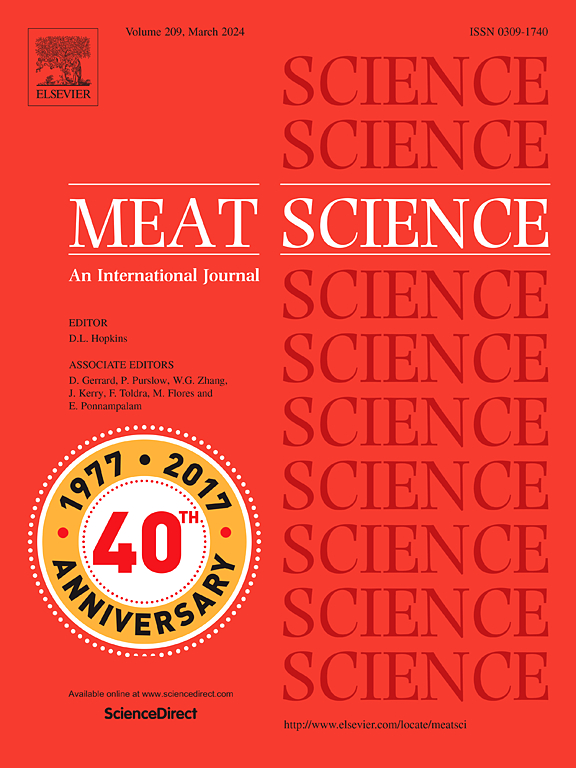Effects of mixing disbudded and horned young bulls during rearing on the post-mortem Longissimus thoracis muscle proteome
IF 6.1
1区 农林科学
Q1 Agricultural and Biological Sciences
引用次数: 0
Abstract
Eighty-one young Swiss cross-bred bulls, half of which were disbudded at 7 weeks of age, were reared in 6 rearing groups. Using a balanced design, these groups contained only horned, or only disbudded bulls (unmixed groups), or both (mixed groups), with only half of the bulls disbudded. They were slaughtered using two protocols, one with limited, the other with supplementary stress. Longissimus thoracis (LT) muscle samples were collected 48 h after slaughter and subjected to individual shotgun proteomic analysis. Results show that horn status and slaughter conditions influenced only 16 (6.2 %) and 8 (3.1 %) proteins, respectively, which is not more than expected by random error. By contrast, rearing conditions influenced 40 (15.5 %) of the identified proteins, which is significantly more than expected by random error. Eighteen of these differentially abundant proteins were involved in energy metabolism, and 9 in muscle structure and contraction. Overall, these proteins indicated greater glycolytic capacity and greater proportions of fast twitch fibres in the LT of bulls in mixed groups. These results are coherent with the lower physical activity and different physiological stress reactivity of these same mixed groups of bulls as reported in previous companion studies.
育成期分离和有角混合对死后胸最长肌蛋白质组的影响
将81头瑞士杂交公牛分为6个饲养组饲养,其中一半在7周龄断奶。使用平衡设计,这些组只包含有角的公牛,或只有脱胎的公牛(未混合组),或两者都包含(混合组),只有一半的公牛脱胎。他们被用两种方法屠宰,一种是有限的,另一种是补充的。屠宰后48小时采集胸最长肌(LT)肌肉样本,进行单个鸟枪蛋白组学分析。结果表明,牛角状态和屠宰条件分别仅影响了16种(6.2%)和8种(3.1%)蛋白质,这并不超过随机误差的预期。相比之下,饲养条件影响了40个(15.5%)鉴定的蛋白质,这明显超过了随机误差的预期。这些差异丰富的蛋白质中有18种与能量代谢有关,9种与肌肉结构和收缩有关。总的来说,这些蛋白质表明混合组公牛的LT中有更大的糖酵解能力和更大比例的快肌纤维。这些结果与之前的相关研究报道的相同混合组公牛的低体力活动和不同的生理应激反应是一致的。
本文章由计算机程序翻译,如有差异,请以英文原文为准。
求助全文
约1分钟内获得全文
求助全文
来源期刊

Meat Science
工程技术-食品科技
CiteScore
12.60
自引率
9.90%
发文量
282
审稿时长
60 days
期刊介绍:
The aim of Meat Science is to serve as a suitable platform for the dissemination of interdisciplinary and international knowledge on all factors influencing the properties of meat. While the journal primarily focuses on the flesh of mammals, contributions related to poultry will be considered if they enhance the overall understanding of the relationship between muscle nature and meat quality post mortem. Additionally, papers on large birds (e.g., emus, ostriches) as well as wild-captured mammals and crocodiles will be welcomed.
 求助内容:
求助内容: 应助结果提醒方式:
应助结果提醒方式:


